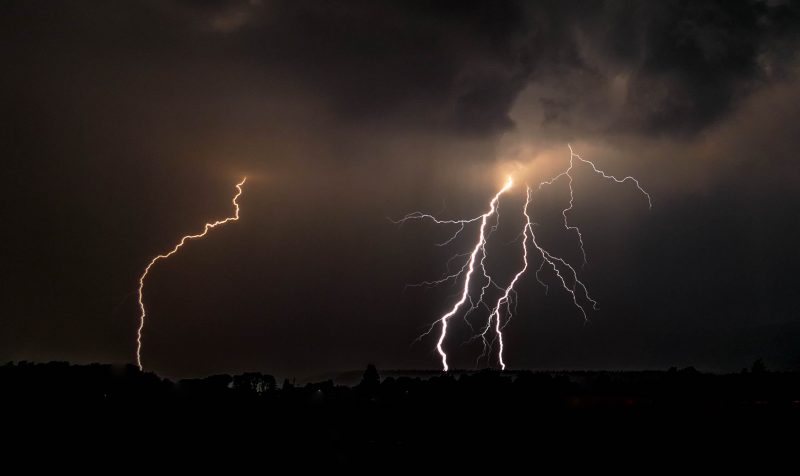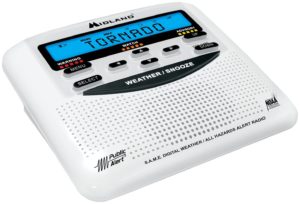 Many thanks to a number of SWLing Post readers who’ve recently contacted me regarding announced closures at Weatheradio Canada. Dennis Dura recently shared this link from the Weatheradio Newsletter which is essentially a call to action to save the Weatheradio service.
Many thanks to a number of SWLing Post readers who’ve recently contacted me regarding announced closures at Weatheradio Canada. Dennis Dura recently shared this link from the Weatheradio Newsletter which is essentially a call to action to save the Weatheradio service.
For those of you not familiar, Weatheradio Canada is very much like NOAA Weather Radio service in the US: essentially, a vast network of transmitters which provide local forecasts and weather warnings. Both Weatheradio Canada and NOAA Weather Radio use seven fixed frequencies of 162.400, 162.425, 162.450, 162.475, 162.500, 162.525, and 162.550 MHz.
I found it difficult to believe that Canada would close their entire network of Weatheradio FM transmitters because, like the US, there are vast rural and remote areas that are well-served by the radio network. I can’t tell you how many times I’ve been camping or travelling outside of mobile phone network coverage in the US and Canada and relied on weather radio for my forecast.
I decided to reach out to Environment and Climate Change Canada and get their official word. Here’s the response I received from their Media Relations representative:
As Canada’s official source for weather forecasts and alerts, Canadians rely on getting the latest current weather conditions from Environment and Climate Change Canada’s (ECCC) Meteorological Service. Since 1871, Canada’s Meteorological Service has continuously adapted to and taken advantage of the latest science and technology to maximize services to Canadians, including those living in remote or Northern areas, or areas without cellular service.
The Weatheradio network, introduced in the 70’s, is made up of 230 transmitting stations. For the most part, these Weatheradio transmitters are in urban areas with plenty of options for accessing weather information and alerts, e.g. internet, mobile apps, radio, television. ECCC has identified 48 Weatheradio transmitters across Canada for potential decommissioning. Of these 48, 12 in Ontario, three are in BC, three in AB, five in SK, four in MB, five in QC, five in NB, three in NS, one in PEI and seven in NL.
In other words, Environment and Climate Change Canada is considering decommissioning about 21% of their Weatheradio transmitters, targeting ones located in urban areas.
I haven’t seen a map of the transmitters marked for potential closure, but I strongly suspect if you live in a very rural area you’re unlikely to be affected.
If you live in an urban area, however, and routinely rely on a weather radio for forecasts and automatic alerts, you may soon only hear static.
If you feel strongly about these potential changes within the Weatheradio Canada network, I suggest you reach out to your Member of Parliament and Environment and Climate Change Canada.


While vacationing along the StLawrence river east of Quebec City i was listening to weather radio canada on 162.475. Cell service is spotty where i am, but depends also on which carrier you’re with.
I was surprised to hear the broadcast giving a date of june 18 2021, when the date was actually june 28 2023.
Two years different !!! System Clock issues ???
I recorded the broadcast, and sent emails an reports to several ECC emails and a problem reporting site, along with the audio file attached in some cases.
Listening to the live broadcast the next day revealed that it was the same recording !!! Has it not changed from 2 years prior.
Seriously !?!?
If technical issues, disable the audio but don’t give out FALSE information ..
Awaiting reply from ECC
Once again we have a working system that costs a trivial amount to operate and maintain, yet Ottawa sees otherwise. Is Ottawa going to pay for apps for those are not going to have SAME coverage? As one with a dozen weather apps on my phone I find them to be clunky to setup and have intermittent reliability in notifications… I am reasonably tech savvy and having issues I can only imagine my aging family member either being woken by unneeded warns or not getting warned about those that result in them being harmed. Ottawa should be ashamed of itself for even discussing such a decommissioning…
I’m in the Ottawa area and just got a NESDR. I am trying to tune in to Weatheradio on 162.4 – 192.55 and can’t pick anything up. Anyone have any updates on the phase out? Am I looking for nothing?
Interesting read. I have signed the petition and sent an email reply to Weatheradio. Thanks for sharing this.
One more thing stripped from us if we do not carry around a cow tag, I mean cellular phone of radiation and 5g damage
There is a petition against the closure of the stations:
https://www.change.org/p/ec-radio-ec-canada-ca-save-weather-radio-canada
Canada is like Australia in that they have high population densities in a strip along the USA border or in Australia 5 main metropolises. The rest of the country has the rest of the population thinly spread.
The telcos advertise that they cover nearly 100 % of the population not 100 % of the land mass, and their power makes the politicians believe that they can cut remote/regional area services. Nature doesn’t work that way!
https://www.researchgate.net/publication/340389471_HF_Digital_Radio_Mondiale_DRM_Broadcast_Summary_Report_For_Long_Range_Dissemination_of_Maritime_Information would be your answer. Remember that Radio Canada International used to transmit programs on high frequency from Sackville. The advantage of DRM over Weather Radio are the following;
1. transmissions can cover far greater areas than the VHF used in Weather Radio.
2. Emergency Warning Functionality will wake the radio and the listeners or retune it from another service when an announcement is made. They can be restricted to areas as small as 7 x 7 km.
3. These transmitters can broadcast Canadian Broadcasting Corporation programming in noise free stereo all of the time including during warning periods. This is particularly useful when being away from home in remote areas. Sufficient power and the selection of the correct frequency is important for reliable reception.
4. Radios are already made which can display images such as maps
5. Journaline is an indexed text system which can contain many forecasts and instructions on what to do to escape
6. It’s TPEG capability means it can send the location of closed roads to vehicle navigation systems to reroute the journey around the blockages.
7. Since different frequencies need to be used at different times the broadcaster can transmit a list and the receiver will automatically retune to the new frequency.
8. To stimulate receiver sales, DRM+ is part of receivers and could use the now virtually vacant TV channels 2 – 6 in which a single transmitter can broadcast up to 18 programs all in noise free stereo and much better quality than AM.
And the disadvantages of DRM over Weather Radio are the following;
1. People don’t have receivers that can decode DRM on shortwave frequencies.
2. People don’t have receivers that tune to your suggested VHF band at all.
3. Nobody’s making receivers for DRM on your suggested band.
4. The user receivers that have been built for DRM are for SW frequencies (experimental, notoriously bad, expensive) and MW frequencies (India only, primarily in cars).
5. Even if someone did make a good receiver for DRM, it’s hard to convince people they have to discard their old ones and buy that. Emergency information would reach very few people.
6. DRM takes more power to decode than analog, meaning that it is harder to power an emergency receiver from a small battery, solar panel, or dynamo.
DRM would be nice, but it’s only going to work if we actually get receivers into the hands of anyone who wants one.
You can integrate RF tuners/chips into smart phones and DRM (or whatever standards) can be decoded in software by an app. Using DRM is as easy and energy efficient as playing your MP3 files on your phone. NO RF rediation, NO airwave bandwidth overload, and portable!
You can integrate receivers into anything, but people don’t. Among other things, DRM is usually broadcast on shortwave frequencies (< 30 MHz). The comment I replied to suggests using a slightly higher band, but still rather low on the VHF spectrum. Each of these requires a long antenna (I think we all know what happens if you're just using a short telescoping antenna for shortwave). Phones don't have room to include that type of antenna. They're unlikely to include an extendable antenna, and they're certainly not going to include a connector for an external one. Now you could connect an SDR to a phone, but that's not going to help all that much if what you really need is emergency information. In an emergency, you can get traditional radio by flipping the radio on switch on a portable receiver or a car. People don't have the time to find the OTG adapter, plug in an SDR, connect an antenna, start up the listener app (assuming you can find a good one which you probably can't), tune to the correct frequency, set up the receiver parameters, and by this point they probably already turned on a normal radio and got the information they want. If DRM is to be used for emergency information, there needs to be the option to own a receiver which can easily tune it in. If it's going to be in a lower frequency range, no phone manufacturer will include it.
I do like the idea of more digital data integrated service, but it will take time to transition from the existing model. So many places sell the current model.
Thanks for posting your info.
It seems like the cost to run these stations would be more than worth it strictly for the emergency alerts. I’m assuming Canada uses the same system as the US does, where we get an alarm that sounds for major events like hurricanes and tornadoes?
Like everyone else, I have have every electronic doodad at my disposal but the alarm on the weather radio is what gets me up in the middle of the night if there’s bad weather in my area, and for that, it’s worth whatever it costs to keep the network running.
That letter was full of roundabout reasons to not cancel. Volunteer weather observers still have their plzce whether this happens or not.
What it seems to be is to get a feeling for demand, before eliminating some stations. A search found a CBC story about this in Nova Scotia. I don’t see anything up at the Weather Radio Canada page.
It’s not unlike the story of cancelling WWVB. It gets comments, but just as there are other ways to get time, there are now lots of clocks that sync to WWVB. Now, there aren’t just standalone weather radios, but in emergency windup radios, CB sets, even FRS walkie talkies. Some of these may be out when people leave their cellphones at home. Of course, I have no cellphone so I see the world differently.
Here in Montreal, presumably an area on the list to lose the transmitter, there are definitely water related warnings. And decisions need to be made not by how few need it, but how important it might be to those who use it.
The government organization title; Environment and Climate Change Canada, seems a bit presumptuous. Never the less, I also tune into our NOAA weather frequencies frequently, especially as Thomas has pointed out when I am camping or on the road. I also have the NWS bookmarked on my iPhone and use the weather apps Weatherbug and Ventusky. There is no doubt that the weather information you can obtain via the internet is phenomenal but there is still a definitive need for the FM broadcasts on 162.XXX.